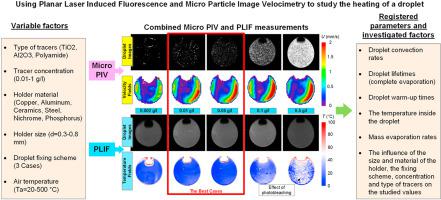当前位置:
X-MOL 学术
›
Int. J. Therm. Sci.
›
论文详情
Our official English website, www.x-mol.net, welcomes your
feedback! (Note: you will need to create a separate account there.)
Using Planar Laser Induced Fluorescence and Micro Particle Image Velocimetry to study the heating of a droplet with different tracers and schemes of attaching it on a holder
International Journal of Thermal Sciences ( IF 4.9 ) Pub Date : 2021-01-01 , DOI: 10.1016/j.ijthermalsci.2020.106603 R.S. Volkov , P.A. Strizhak
International Journal of Thermal Sciences ( IF 4.9 ) Pub Date : 2021-01-01 , DOI: 10.1016/j.ijthermalsci.2020.106603 R.S. Volkov , P.A. Strizhak

|
Abstract The Planar Laser Induced Fluorescence optical technique is used to measure the droplet temperature field, and the Micro Particle Image Velocimetry – the velocities of natural convection in the droplet. We focus on the convection, vortex formation centers, convection velocities, and the influence of convection on the temperature in different droplet sections. The most common tracer particles are used (Al2O3, TiO2, polyamide). Differences in the temperature fields of evaporating droplets with tracers and without them are analyzed. We compare the reliability of measuring droplet temperature using Planar Laser Induced Fluorescence and fast-response thermocouples. The concentrations of tracers are varied to establish the ranges in which the fields of temperature and convection velocities can be reliably measured in rapidly heated and evaporating droplets. We study the influence of typical holder materials on droplet heating rates. Metal rods, wires, and nichrome wires are used. The focus is on illustrating the influence of the holder type and material on the droplet temperature field, its heating and evaporation rates, as well as its lifetime. We consider typical schemes of droplet fixation on holders, as well as the main differences in the fields of temperature and convection velocities in different droplet sections. As a result, we have obtained the concentrations of Al2O3 and TiO2 tracers that make it possible to use both Planar Laser Induced Fluorescence and Micro Particle Image Velocimetry at the same time. Examples are given of particle agglomeration and photobleaching. The use of polyamide particles as tracers is found not feasible for evaluating the convection rates in droplets, because they are displaced from the deep layers of a droplet to the surface. It is established that if a Rhodamine B solution contains Al2O3 and TiO2 tracers, the fluorophore settles on those particles, which may degrade the accuracy of temperature measurement using Planar Laser Induced Fluorescence. The experimental findings are important to develop the fields of research into the conditions and characteristics of heating droplets, films, and liquid jets, using Planar Laser Induced Fluorescence and Micro Particle Image Velocimetry.
中文翻译:

使用平面激光诱导荧光和微粒图像测速法研究具有不同示踪剂的液滴的加热以及将其附着在支架上的方案
摘要 平面激光诱导荧光光学技术用于测量液滴温度场,以及微粒子图像测速——液滴中自然对流的速度。我们关注对流、涡流形成中心、对流速度以及对流对不同液滴截面温度的影响。使用最常见的示踪粒子(Al2O3、TiO2、聚酰胺)。分析了带示踪剂和不带示踪剂的蒸发液滴的温度场差异。我们比较了使用平面激光诱导荧光和快速响应热电偶测量液滴温度的可靠性。示踪剂的浓度是变化的,以确定可以在快速加热和蒸发的液滴中可靠地测量温度和对流速度场的范围。我们研究了典型支架材料对液滴加热速率的影响。使用金属棒、线和镍铬合金线。重点是说明支架类型和材料对液滴温度场、加热和蒸发速率以及寿命的影响。我们考虑了液滴固定在支架上的典型方案,以及不同液滴截面中温度和对流速度领域的主要差异。因此,我们已经获得了 Al2O3 和 TiO2 示踪剂的浓度,这使得同时使用平面激光诱导荧光和微粒图像测速成为可能。给出了粒子团聚和光漂白的例子。发现使用聚酰胺颗粒作为示踪剂对于评估液滴中的对流率是不可行的,因为它们从液滴的深层转移到表面。已经确定,如果罗丹明 B 溶液含有 Al2O3 和 TiO2 示踪剂,荧光团会沉积在这些颗粒上,这可能会降低使用平面激光诱导荧光进行温度测量的准确性。实验结果对于开发加热液滴、薄膜和液体射流的条件和特性的研究领域很重要,
更新日期:2021-01-01
中文翻译:

使用平面激光诱导荧光和微粒图像测速法研究具有不同示踪剂的液滴的加热以及将其附着在支架上的方案
摘要 平面激光诱导荧光光学技术用于测量液滴温度场,以及微粒子图像测速——液滴中自然对流的速度。我们关注对流、涡流形成中心、对流速度以及对流对不同液滴截面温度的影响。使用最常见的示踪粒子(Al2O3、TiO2、聚酰胺)。分析了带示踪剂和不带示踪剂的蒸发液滴的温度场差异。我们比较了使用平面激光诱导荧光和快速响应热电偶测量液滴温度的可靠性。示踪剂的浓度是变化的,以确定可以在快速加热和蒸发的液滴中可靠地测量温度和对流速度场的范围。我们研究了典型支架材料对液滴加热速率的影响。使用金属棒、线和镍铬合金线。重点是说明支架类型和材料对液滴温度场、加热和蒸发速率以及寿命的影响。我们考虑了液滴固定在支架上的典型方案,以及不同液滴截面中温度和对流速度领域的主要差异。因此,我们已经获得了 Al2O3 和 TiO2 示踪剂的浓度,这使得同时使用平面激光诱导荧光和微粒图像测速成为可能。给出了粒子团聚和光漂白的例子。发现使用聚酰胺颗粒作为示踪剂对于评估液滴中的对流率是不可行的,因为它们从液滴的深层转移到表面。已经确定,如果罗丹明 B 溶液含有 Al2O3 和 TiO2 示踪剂,荧光团会沉积在这些颗粒上,这可能会降低使用平面激光诱导荧光进行温度测量的准确性。实验结果对于开发加热液滴、薄膜和液体射流的条件和特性的研究领域很重要,









































 京公网安备 11010802027423号
京公网安备 11010802027423号